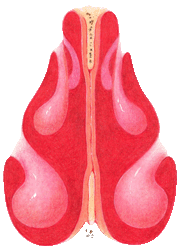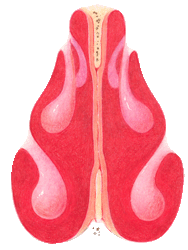|
|
|
|
|
|
SLEEP APNEA SURGERY
Radiofrequency
The volume of soft tissue can be reduced with the application of radiofrequency energy. This treatment procedure is usually performed in the office. A local anesthetic is first injected into the tissue. A probe is then inserted into the tissue, transmitting radiofrequency energy. Minimal discomfort is generally experienced during the application of this procedure. During the healing process (within 1-3 weeks), scar tissue forms and causes the tissue's overall size to decrease. The nasal turbinates, soft palate and tongue can be shrunk in size to increase airway space.
A significant advantage of radiofrequency treatment is its precision in targeting tissue. Because the treated tissue remains within 60-90 degrees Celsius, heat dissipation to the surrounding tissues is limited, thus minimizing excessive tissue injury and complications.
Nasal Turbinates
Inferior turbinate hypertrophy is a frequent cause of nasal airway obstruction. The size of the turbinate can be reduced by radiofrequency to improve nasal breathing. The procedure is performed in the office under local anesthesia. The treatment takes only a few minutes, in which there is minimal discomfort. There is no restriction in activity after the treatment. However, nasal stuffiness is present for 3-5 days after treatment.
|
|
|
|

(Pre - Op)
|
|

(Post - Op)
|
|
Soft Palate
Soft palate redundancy is a frequent cause of airway obstruction in OSA. Radiofrequency energy can be applied to the soft palate to stiffen the tissue. However, this treatment is only helpful in patients with mild OSA. The treatment takes only a few minutes and is associated with minimal discomfort. There is no restriction in activity after the treatment. However, sleep and swallowing can be somewhat affected for 2-3 days because of the temporary swelling of the soft palate after treatment.
Tongue
The tongue is a frequent cause of airway obstruction in OSA. The airway can be improved by reducing the tongue volume with radiofrequency. The treatment takes only a few minutes, in which there is minimal discomfort. Potential complications include significant swelling and infection. Since the risk of complications is directly associated with the amount of radiofrequency that is applied, multiple treatment sessions are required to limit the amount of energy delivered during each treatment.
|
|
|
